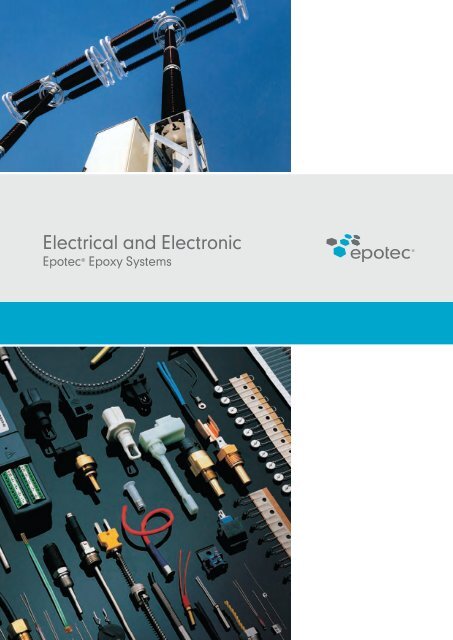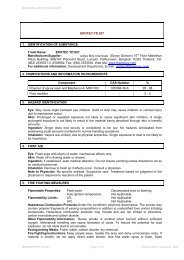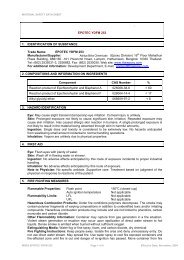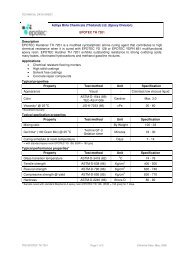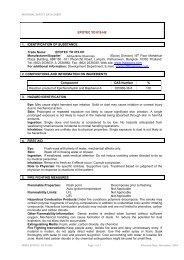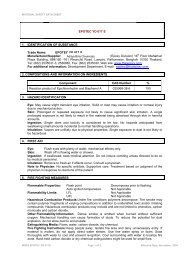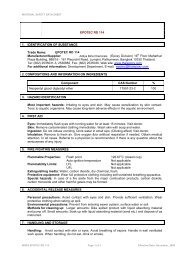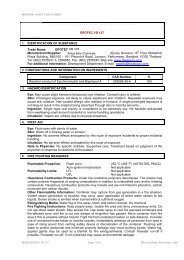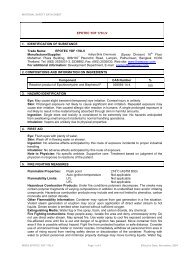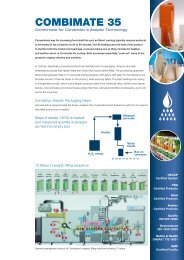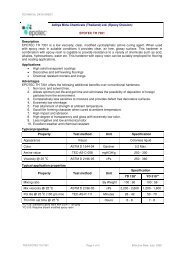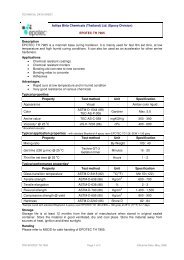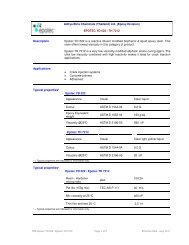Epotec - electrical and electronic applications - Aditya Birla Chemicals
Epotec - electrical and electronic applications - Aditya Birla Chemicals
Epotec - electrical and electronic applications - Aditya Birla Chemicals
You also want an ePaper? Increase the reach of your titles
YUMPU automatically turns print PDFs into web optimized ePapers that Google loves.
Electrical <strong>and</strong> Electronic<br />
<strong>Epotec</strong> ® Epoxy Systems<br />
®
Transcending the conventional barriers of business<br />
to send out a message that “We Care”<br />
The <strong>Aditya</strong> <strong>Birla</strong> Group<br />
A US $29.2 billion corporation, the <strong>Aditya</strong> <strong>Birla</strong><br />
Group is in the League of Fortune 500. It is<br />
anchored by an extraordinary force of 130,000<br />
employees, belonging to 30 different nationalities.<br />
In India, the Group has been adjudged “The Best<br />
Employer in India <strong>and</strong> among the top 20 in Asia” by<br />
the Hewitt-Economic Times <strong>and</strong> Wall Street Journal<br />
Study 2007. Over 60 per cent of its revenues flow<br />
from its overseas operations.<br />
The Group operates in 25 countries - India, UK,<br />
Germany, Hungary, Brazil, Italy, France,<br />
Luxembourg, Switzerl<strong>and</strong>, Australia, USA, Canada,<br />
Egypt, China, Thail<strong>and</strong>, Laos, Indonesia,<br />
Philippines, Dubai, Singapore, Myanmar,<br />
Bangladesh, Vietnam, Malaysia <strong>and</strong> Korea.<br />
A Global Perspective<br />
A metals powerhouse, among the world’s most<br />
cost-efficient aluminium <strong>and</strong> copper producers.<br />
Hindalco-Novelis is the largest aluminium rolling<br />
company. It is one of the 3 biggest producers of<br />
primary aluminium in Asia, with the largest single<br />
location copper smelter.<br />
No. 1 in viscose staple fibre.<br />
The 4 th largest producer of insulators.<br />
The 4 th largest producer of carbon black.<br />
The 11 th largest cement producer globally, the 7 th<br />
largest in Asia <strong>and</strong> the 2 nd largest in India.<br />
Among the world’s top 15 BPO companies <strong>and</strong><br />
among India’s top 4.<br />
Among the best energy efficient fertilizer plants.<br />
In India<br />
A premier br<strong>and</strong>ed garments player.<br />
The 2 nd largest player in viscose filament yarn.<br />
The 2 nd largest in the Chlor-alkali sector.<br />
Among the top 5 mobile telephony companies.<br />
A leading player in Life Insurance <strong>and</strong> Asset<br />
Management.<br />
Among the top 3 super-market chains in the Retail<br />
business.<br />
Beyond Business<br />
The <strong>Aditya</strong> <strong>Birla</strong> Group is working in 3,700 villages,<br />
reaching out to 7 million people annually through<br />
the <strong>Aditya</strong> <strong>Birla</strong> Centre for Community Initiatives <strong>and</strong><br />
Rural Development, spearheaded by Mrs.<br />
Rajashree <strong>Birla</strong>. The Group’s functions span 42<br />
schools <strong>and</strong> 18 hospitals, furthering its focus on<br />
health care, education, sustainable livelihood,<br />
infrastructure <strong>and</strong> social causes.<br />
For more information visit www.adityabirla.com<br />
2<br />
<strong>Epotec</strong> ® Epoxy Systems | Electrical <strong>and</strong> Electronic
Our Company acts as a solution provider, formulating specialized<br />
Epoxy systems for your specific performance needs.<br />
<strong>Aditya</strong> <strong>Birla</strong> <strong>Chemicals</strong>, Epoxy Division<br />
Thai Epoxy <strong>and</strong> Allied Products Company Limited<br />
(Thai Epoxy), has recently been transformed to the<br />
Epoxy Division of <strong>Aditya</strong> <strong>Birla</strong> <strong>Chemicals</strong> (Thail<strong>and</strong>)<br />
Limited. It is part of the <strong>Aditya</strong> <strong>Birla</strong> Group of<br />
Companies. Being the pioneer manufacturer of<br />
epoxy resins in the ASEAN region, the Company<br />
constitutes its success on its Specialized Epoxy<br />
Systems <strong>and</strong> its complete in-house Research <strong>and</strong><br />
Application Development Center. Sustainability has<br />
also been achieved through its group-wide unique<br />
World Class Manufacturing (WCM) strategy for<br />
enterprise excellence.<br />
Located within the prestigious Map Tha Phut<br />
Industrial Estate at Rayong Province in Thail<strong>and</strong>, the<br />
Company started commercial production in 1992<br />
with technology from Tohto Kasei Company Limited,<br />
Japan’s largest producer of epoxy resins. The<br />
Company is currently accredited <strong>and</strong> certified with<br />
ISO 9001:2000 <strong>and</strong> ISO 14001 in recognition of its<br />
quality <strong>and</strong> environment management systems.<br />
The Company offers a wide range of epoxies <strong>and</strong><br />
modifiers that vary in chemical structure, molecular<br />
weight, viscosity <strong>and</strong> functionality. All products are<br />
marketed under the trade name of <strong>Epotec</strong> ® ,<br />
including liquid, solid, solutions, blends <strong>and</strong> other<br />
multifunctional epoxy resins. Epoxy Resin, a<br />
performance polymer, is a versatile resin which<br />
finds application in adhesives, civil engineering,<br />
composites, casting <strong>and</strong> encapsulation of <strong>electrical</strong><br />
components, <strong>and</strong> coatings including protective,<br />
marine, floor, powder, can <strong>and</strong> coil.<br />
The Company stretches its business arms in all six<br />
continents of the globe.<br />
Certified ISO 9001:2000 by<br />
Certified ISO 14001 by<br />
008 008<br />
<strong>Epotec</strong> ® Epoxy Systems | Electrical <strong>and</strong> Electronic<br />
3
®<br />
Electrical <strong>and</strong> Electronic<br />
This booklet highlights the <strong>Epotec</strong> ® range<br />
of Epoxy Systems for Electrical <strong>and</strong><br />
Electronic Applications. These systems<br />
find end-use in the following components:<br />
Electrical Components<br />
Current Transformer<br />
Power Transformer<br />
Instrument Transformer<br />
Switchgear Component<br />
Insulators<br />
Bushing<br />
Electronic Components<br />
Power Semi-conductor<br />
Capacitors<br />
Inductive Components<br />
Ignition Coils<br />
Filter Circuits<br />
Proximity Switches<br />
Modules<br />
Relays<br />
Connectors<br />
Sensors<br />
Switch Mode Transformers<br />
From the beginning of the <strong>electrical</strong> <strong>and</strong> <strong>electronic</strong><br />
industry, critical circuit components have been<br />
coated, buried or otherwise encased in dielectric<br />
materials to isolate them from adverse<br />
environmental <strong>and</strong> operational effects such as<br />
oxygen, moisture, temperature, <strong>electrical</strong> flashers,<br />
current leakage, salt spay, radiation, solvent,<br />
chemicals, micro-organisms, mechanical shock<br />
<strong>and</strong> vibrations. The first materials used for this<br />
purpose were waxes <strong>and</strong> asphalted polymer.<br />
Although these substances are still used to some<br />
extent, synthetic polymers, such as epoxy resins,<br />
are now most widely used in <strong>electrical</strong><br />
encapsulation.<br />
The benefits <strong>and</strong> importance of epoxy resins have<br />
been recognized after World War II by the <strong>electrical</strong><br />
<strong>and</strong> <strong>electronic</strong> industries as a self-supporting<br />
insulating material. Our Company, since its<br />
inception, has given prime importance to this<br />
segment. As a result of intensive development work<br />
in close cooperation with our customers, our<br />
Company has compiled its present broad range of<br />
resins, curing agents <strong>and</strong> resin systems available to<br />
meet the wide variety of requirements stipulated in<br />
national <strong>and</strong> international st<strong>and</strong>ards.<br />
Our goal is to continue our focus on quality <strong>and</strong><br />
innovation thereby partnering the <strong>electrical</strong> <strong>and</strong><br />
<strong>electronic</strong> industry in their technical progress. It is<br />
part of our philosophy not only to safeguard high<br />
<strong>and</strong> consistent product quality, but also to support<br />
our customers with information <strong>and</strong> technical<br />
service when using our products. This intent is<br />
borne out of our activities including, our willingness<br />
to supply processing information literature <strong>and</strong><br />
other solutions to technical problems. Development<br />
of tailored systems for specific customer<br />
requirements is also part of our philosophy.<br />
Up-to-date Research & Development facility <strong>and</strong><br />
the services of an Application Development Center<br />
are available for product development <strong>and</strong> technical<br />
support to our customers.<br />
4<br />
<strong>Epotec</strong> ® Epoxy Systems | Electrical <strong>and</strong> Electronic
Formulation<br />
<strong>Epotec</strong> ® Epoxy Systems offer ready to use<br />
formulated products, however, users may select<br />
appropriate filler, diluents, plasticizers, modifiers,<br />
<strong>and</strong> pigments according to their choice.<br />
Fillers are an important part of the formulation <strong>and</strong><br />
mixed about 2 to 3 times of epoxy resin. Due to<br />
high loading, fillers become an important<br />
component for <strong>electrical</strong> <strong>and</strong> <strong>electronic</strong><br />
manufacturers.<br />
Several common fillers are used to achieve the<br />
desired end properties. Single or combinations of<br />
fillers can be used with or without treatment. Fillers<br />
treated by silanes provide excellent wetting, low mix<br />
viscosity, strong bonding with matrix, <strong>and</strong> prevent<br />
sedimentation during long storage.<br />
Fillers modify the properties of the mix resulting<br />
in the following benefits:<br />
Reduced cost.<br />
Increased abrasion resistance.<br />
Increased rigidity <strong>and</strong> impact strength.<br />
Reduced shrinkage <strong>and</strong> water absorption.<br />
Increased heat deflection temperature.<br />
Modified <strong>electrical</strong> <strong>and</strong> thermal properties.<br />
Reduced flammability.<br />
Reduced flexural <strong>and</strong> tensile strength.<br />
Selection of Fillers<br />
Silica quartz<br />
Alumina trihydrate (ATH)<br />
Alumina<br />
Mica<br />
Calcium carbonate<br />
Hollow glass sphere<br />
Carbon black<br />
Metallic powder<br />
Common Properties<br />
High <strong>electrical</strong> properties.<br />
Fire retardant <strong>applications</strong>.<br />
Excellent abrasion resistance.<br />
High thermal resistance<br />
Common filler, high surface area <strong>and</strong> resin absorption.<br />
Light weight <strong>and</strong> good surface finish.<br />
High thermal stability <strong>and</strong> semi-conducting properties.<br />
Modification of <strong>electrical</strong> <strong>and</strong> thermal properties.<br />
<strong>Epotec</strong> ® Epoxy Systems | Electrical <strong>and</strong> Electronic<br />
5
®<br />
Processes & Applications<br />
<strong>Epotec</strong> ® Epoxy Systems are best known for casting<br />
into molds, cavities, cores <strong>and</strong> patterns. They are<br />
also extensively used for encapsulation<br />
(encapsulation <strong>and</strong> embedment are frequently used<br />
inter-changeably), impregnation <strong>and</strong> protection of<br />
<strong>electrical</strong> <strong>and</strong> <strong>electronic</strong> assemblies <strong>and</strong><br />
components. Usually low-pressure-reacted resins<br />
are utilized <strong>and</strong> curing is performed at room<br />
temperature to elevated temperature, up to 200°C.<br />
Room temperature curing <strong>Epotec</strong> ® Systems are<br />
preferred for low voltage, small components, while<br />
heat-cured <strong>Epotec</strong> ® Systems offer extremely high<br />
physical, thermal <strong>and</strong> chemical resistance. As such,<br />
heat-cured <strong>Epotec</strong> ® Systems are used for medium<br />
<strong>and</strong> high voltage <strong>applications</strong>.<br />
There are few common process techniques for use<br />
of <strong>Epotec</strong> ® Epoxy Resins in <strong>electrical</strong> <strong>and</strong> <strong>electronic</strong><br />
components.<br />
Pottings<br />
Potting is a variation of casting in which the<br />
prefabricated mold, a thin shell of metal or plastic,<br />
becomes an integral part of the finished product.<br />
The resin is fluid enough to flow around the<br />
components being embedded <strong>and</strong> fills all voids,<br />
including the container. Potting is used frequently to<br />
reduce weight, avoid breakdown <strong>and</strong> prevent failure<br />
due to moisture <strong>and</strong> vibration in components.<br />
Encapsulation<br />
Encapsulation is a method of providing a protective<br />
coating on the inside of coils, closed-packed<br />
<strong>electronic</strong> assemblies <strong>and</strong> wire bundles. For<br />
saturation of components it is essential to select<br />
<strong>Epotec</strong> ® Resins of high flow <strong>and</strong> high wetting<br />
properties. The components finally are surrounded<br />
by a thin film of resin. Components encapsulated in<br />
this manner maintain high <strong>electrical</strong> insulation,<br />
excellent environmental protection against heat,<br />
moisture <strong>and</strong> chemicals, <strong>and</strong> also protect<br />
micro<strong>electronic</strong> assemblies with their fine interconnection.<br />
Impregnation<br />
Encapsulation is more of a coating process which<br />
allows minimum penetration of resin into compact<br />
assemblies, whereas impregnation is a process<br />
specifically designed to ensure that the liquid resin<br />
has completely entered into interstices of assembly<br />
prior to curing. Some transformer <strong>and</strong> <strong>electronic</strong><br />
equipment manufacture requires both encapsulation<br />
<strong>and</strong> impregnation.<br />
6<br />
<strong>Epotec</strong> ® Epoxy Systems | Electrical <strong>and</strong> Electronic
Castings<br />
In this technique, a mold is prepared to give the proper dimensions to the finished part. The molds are designed<br />
to provide minimum internal stresses as the resin shrinks during curing. The resin, curing agent <strong>and</strong> fillers are<br />
mixed <strong>and</strong> poured slowly into the mold, preferably in a vacuum to avoid air entrapment. The entire assembly is<br />
then cured either at room temperature, by its own exothermic heat or in an oven. The part is then released from<br />
the mold. Castings technique is divided into the following subcategories:<br />
7<br />
4<br />
5<br />
6<br />
Vacuum Casting<br />
In this process, epoxy compound, including resin,<br />
curing agent <strong>and</strong> filler, are poured under gravity into<br />
steel molds under vacuum. Partially cured<br />
components are demolded <strong>and</strong> post curing is<br />
performed in oven.<br />
3 3 3<br />
7<br />
1 Autoclave<br />
2<br />
2 Static Mixer / Buffer Tank<br />
3 Dosing Pump<br />
4 Resin Tank<br />
8<br />
1<br />
5 Flexibilizer / Accelerator Tank<br />
6 Curing Agent Tank<br />
7 Vacuum Plant<br />
8 Control Panel<br />
6<br />
6<br />
4 5<br />
3 3<br />
Automation Pressure Gelation (APG) or Liquid<br />
Injection Molding (LIM)<br />
In this process, the liquid epoxy compound,<br />
premixed with fillers <strong>and</strong> additives, is directly<br />
pumped into a split mold which is v-mounted on a<br />
clamping machine. Only gelling step is allowed in<br />
the mold <strong>and</strong> final curing of component is<br />
performed in separate oven. This method allows to<br />
compensate for chemical shrinkage <strong>and</strong> is used<br />
extensively for mass production of insulating<br />
components for <strong>electrical</strong> industries.<br />
7 1<br />
1<br />
2 2<br />
1 APG Clamping Unit<br />
2 Static Mixer<br />
3 Dosing Unit<br />
4 Resin Mixing Tank<br />
5 Curing Agent Mixing Tank<br />
6 Vacuum Plant<br />
7 Control Panel<br />
NOTE: The above diagrams only demonstrate a simple representation<br />
of the associated processes. This is only for a purpose of reference,<br />
<strong>and</strong> may not be accurate in terms of details <strong>and</strong> scaling.<br />
<strong>Epotec</strong> ® Epoxy Systems | Electrical <strong>and</strong> Electronic<br />
7
®<br />
Typical Properties of <strong>Epotec</strong> ® Epoxy Systems for Electrical <strong>and</strong> Electronic Applications<br />
TABLE 1.0 Electrical <strong>and</strong> Electronic Applications<br />
EPOTEC ® SYSTEMS<br />
UNIT<br />
Resin<br />
100 pbw 1<br />
YDC 6001<br />
YDC 6002<br />
YDC 6004<br />
YDC 6015<br />
YDC 6003<br />
YDC 6003<br />
YDC 6030<br />
YDC 6006<br />
YDH 184<br />
YDH 184<br />
YDH 184M1<br />
YDC 6020i<br />
YDC 6029<br />
YDC 6018<br />
Curing Agent<br />
pbw 1<br />
TH 7656 / 30<br />
TH 7656 / 30<br />
TH 7657 / 100<br />
TH 7652 P1 / 80<br />
TH 7658 / 80<br />
TH 7662 / 80<br />
TH 7670 / 82<br />
TH 7269 / 9 - 10<br />
TH 7351 / 90<br />
TH 7356 / 90<br />
TH 7356P / 80<br />
TH 7652i / 32<br />
TH 7668 / 30<br />
TH 8251 / 18<br />
Accelerator<br />
pbw 1<br />
-<br />
-<br />
TA 7852 / 1<br />
-<br />
-<br />
-<br />
TA 7854 / 0.5 - 2<br />
-<br />
TA 7851 / 0.5 - 3<br />
TA 7851 / 0.5 - 2<br />
-<br />
TA 7851 / 1.5<br />
-<br />
-<br />
Flexibilizer<br />
pbw 1<br />
-<br />
-<br />
TP 01 / 10<br />
TP 01 / 0 - 8<br />
-<br />
-<br />
-<br />
-<br />
-<br />
-<br />
-<br />
-<br />
-<br />
-<br />
Filler (silica flour 300 mesh)<br />
pbw 1<br />
200<br />
200<br />
400<br />
320 - 350<br />
270<br />
270<br />
270<br />
150<br />
300<br />
270<br />
270<br />
Prefilled<br />
Prefilled<br />
Prefilled<br />
Filler loading (pbw 1 filler)<br />
%<br />
61<br />
61<br />
65<br />
65<br />
60<br />
60<br />
60<br />
58<br />
61<br />
61<br />
61<br />
-<br />
-<br />
-<br />
Curing condition<br />
Hot Cure<br />
Hot Cure<br />
Hot Cure<br />
Hot Cure<br />
Hot Cure<br />
Hot Cure<br />
Hot Cure<br />
Ambient Cure<br />
Hot Cure<br />
Hot Cure<br />
Hot Cure<br />
Hot Cure<br />
Hot Cure<br />
Ambient Cure<br />
Processing technique<br />
CVC<br />
CVC<br />
CVC<br />
CVC, PG, APG<br />
CVC, PG, APG<br />
CVC, PG, APG<br />
CVC, APG<br />
CVC<br />
CVC, PG, APG<br />
CVC, PG, APG<br />
CVC, PG, APG<br />
CVC<br />
CVC<br />
CVC<br />
Processing temperature<br />
˚C<br />
120 - 140<br />
120 - 140<br />
Ambient - 80<br />
Ambient - 80<br />
Ambient - 80<br />
Ambient - 80<br />
60 - 80<br />
Ambient<br />
40 - 80<br />
40 - 80<br />
40 - 80<br />
60 - 80<br />
60 - 80<br />
RT<br />
Initial viscosity of mix<br />
mPa s/˚C<br />
1,900 / 120<br />
500 / 140<br />
-<br />
-<br />
4,000 / 120<br />
2,500 / 140<br />
-<br />
-<br />
1,500 / 80<br />
-<br />
-<br />
-<br />
10,000 / 60<br />
1,500 / 80<br />
-<br />
-<br />
40,000 / 40<br />
1,000 / 80<br />
-<br />
-<br />
70,000 / 40<br />
1,500 / 80<br />
-<br />
-<br />
1,700 / 60<br />
-<br />
-<br />
-<br />
8,500 / 25<br />
-<br />
-<br />
-<br />
1,000 / 80<br />
-<br />
-<br />
-<br />
100 / 80<br />
-<br />
-<br />
-<br />
6,400 / 25<br />
3,000 / 40<br />
700 / 60<br />
-<br />
700 - 900 / 25<br />
-<br />
-<br />
-<br />
2,500 - 3,500 / 25<br />
-<br />
-<br />
-<br />
-<br />
-<br />
-<br />
-<br />
Pot life of mix (< 5kg)<br />
h/˚C<br />
6 / 120<br />
1 / 120<br />
14 / 40<br />
24 - 48 / 25<br />
15 / 40<br />
15 / 40<br />
24 - 48 / 25<br />
0.5 / 25<br />
1 / 80<br />
4 / 60<br />
4 / 60<br />
24 - 36 / 25<br />
24 - 36 / 25<br />
0.5 / 25<br />
-<br />
0.5 / 140<br />
1.5 / 80<br />
-<br />
2 / 80<br />
2 / 80<br />
-<br />
(100g mix)<br />
-<br />
1 / 80<br />
1 / 80<br />
-<br />
-<br />
-<br />
Gel time<br />
min/˚C<br />
780 / 110<br />
330 / 130<br />
150 / 150<br />
160 / 120<br />
60 / 140<br />
-<br />
100 / 80<br />
35 / 100<br />
15 / 120<br />
20 / 120<br />
-<br />
-<br />
285 / 80<br />
14 / 120<br />
8 / 140<br />
270 / 80<br />
15 / 120<br />
8 / 140<br />
80 - 90 / 120<br />
25 - 30 / 140<br />
-<br />
-<br />
-<br />
-<br />
4 / 140<br />
3 / 150<br />
2 / 160<br />
4 / 140<br />
3 / 150<br />
2 / 160<br />
11 / 120<br />
5 / 140<br />
-<br />
40 / 80<br />
4 / 120<br />
-<br />
115 - 150 / 80<br />
30 - 40 / 100<br />
-<br />
-<br />
-<br />
-<br />
Minimum cure time<br />
h/˚C<br />
16 / 140<br />
14 / 140<br />
3 / 120<br />
10 / 140<br />
6 / 80 + 10 / 130<br />
6 / 80 + 10 / 130<br />
6 / 80 + 10 / 130<br />
6 / 80<br />
6 / 80 + 10 / 140<br />
6 / 80 + 10 / 140<br />
6 / 80 + 10 / 140<br />
4 / 80 + 2 / 130<br />
4 / 80 + 2 / 130<br />
24 / RT<br />
Minimum postcure time<br />
h/˚C<br />
-<br />
-<br />
-<br />
-<br />
6 / 140<br />
6 / 140<br />
-<br />
-<br />
-<br />
-<br />
-<br />
-<br />
-<br />
-<br />
NOTE: CVC - Conventional Vacuum Casting, PG - Pressure Gelation, APG - Automatic Pressure Gelation<br />
1 Part by weight (pbw)<br />
PROPERTIES OF CASTING<br />
METHOD<br />
UNIT<br />
Tensile strength<br />
ISO 527<br />
N/mm 2<br />
85 - 95<br />
80 - 100<br />
70 - 80<br />
75 - 85<br />
70 - 80<br />
75 - 85<br />
75 - 85<br />
35 - 45<br />
90 - 100<br />
90 - 100<br />
70 - 90<br />
40 - 60<br />
30 - 50<br />
5 - 10<br />
Elongation at break<br />
ISO 527<br />
%<br />
1.1 - 1.5<br />
1.0 - 1.5<br />
0.8 - 1.2<br />
1.1 - 1.3<br />
1.0 - 1.5<br />
1 - 2<br />
1 - 2<br />
2 - 4<br />
1.7 - 1.9<br />
1.7 - 1.9<br />
1.3 - 1.5<br />
-<br />
-<br />
1.5<br />
Flexural strength<br />
ISO 178<br />
N/mm 2<br />
135 - 145<br />
130 - 150<br />
115 - 125<br />
135 - 155<br />
110 - 130<br />
110 - 120<br />
110 - 140<br />
90 - 100<br />
150 - 165<br />
150 - 165<br />
150 - 170<br />
70 - 90<br />
70 - 90<br />
15 - 20<br />
Impact strength<br />
ISO / R 179<br />
kJ/mm 2<br />
15 - 22<br />
15 - 22<br />
10 - 15<br />
-<br />
7 - 10<br />
11 - 13<br />
10 - 15<br />
7 - 10<br />
8 - 9<br />
8 - 9<br />
-<br />
8 - 11<br />
8-11<br />
-<br />
Elastic modulus in tension<br />
ISO / R 527<br />
N/mm 2<br />
10,000 - 11,000<br />
12,000 - 14,000<br />
12,000 - 14,000<br />
-<br />
9,000 - 11,000<br />
9,000 - 11,000<br />
10,000 - 12,000<br />
15,500 - 16,000<br />
10,000 - 11,000<br />
10,000 - 11,000<br />
10,500 - 12,000<br />
-<br />
-<br />
1400 - 1800<br />
Deflection temperature (HDT)<br />
ISO / R 75<br />
˚C<br />
110 - 120<br />
110 - 120<br />
80 - 90<br />
100 - 110<br />
105 - 120<br />
95 - 105<br />
80 - 90<br />
65 - 70<br />
95 - 105<br />
95 - 110<br />
72 - 80<br />
75 - 85<br />
85 - 95<br />
55 - 65<br />
Glass transition point<br />
DSC<br />
˚C<br />
115<br />
115<br />
90 - 100<br />
100 - 110<br />
110 - 125<br />
100 - 110<br />
85 - 95<br />
55 - 65<br />
100 - 110<br />
100 - 110<br />
75 - 80<br />
75 - 90<br />
90 - 105<br />
60 - 70<br />
Water absorption 1 (23˚C / 10 days)<br />
ISO / R 62<br />
% w/w<br />
0.15 - 0.25<br />
0.15 - 0.25<br />
0.1 - 0.2<br />
-<br />
0.10 - 0.15<br />
0.1 - 0.2<br />
0.1 - 0.2<br />
0.4<br />
0.1 - 0.2<br />
0.1 - 0.2<br />
0.1 - 0.2<br />
< 0.15<br />
< 0.15<br />
0.2 - 0.4 (24 hrs)<br />
Tan d at 50 Hz (23˚C)<br />
IEC 60250<br />
%<br />
1.5<br />
2 - 3<br />
2 - 3<br />
2 - 3<br />
2.5<br />
3<br />
2 - 3<br />
0.32 - 0.37<br />
2<br />
2<br />
2<br />
2 - 3<br />
2 - 3<br />
1 - 2<br />
Arc resistance<br />
ASTM D-495<br />
sec<br />
180 - 190<br />
185 - 190<br />
185 - 195<br />
180 - 190<br />
182 - 186<br />
182 - 186<br />
180 - 190<br />
180<br />
185 - 190<br />
185 - 190<br />
185 - 190<br />
180 - 190<br />
180 - 190<br />
-<br />
Tracking resistance (CTI)<br />
IEC 60112<br />
V<br />
> 400<br />
> 400<br />
> 600<br />
> 600<br />
> 600<br />
> 600<br />
> 600<br />
400<br />
> 600<br />
> 600<br />
> 600<br />
> 600<br />
> 600<br />
> 600<br />
Electrical strength 2 (23˚C / 50 Hz)<br />
IEC 60243 - 1<br />
kV/mm<br />
22 - 24<br />
22 - 25<br />
18 - 22<br />
17 - 21<br />
18 - 20<br />
18 - 20<br />
18 - 22<br />
18 - 22<br />
19 - 21<br />
19 - 22<br />
6 - 10<br />
17 - 20<br />
> 20<br />
6 - 8<br />
1 60 x 10 x 4 mm test specimens, 2 20 seconds value for 2 mm sheet<br />
8<br />
<strong>Epotec</strong> ® Epoxy Systems | Electrical <strong>and</strong> Electronic<br />
<strong>Epotec</strong> ® Epoxy Systems | Electrical <strong>and</strong> Electronic<br />
10
Important Considerations for <strong>Epotec</strong> ® Resins<br />
The epoxy casting resins, generally, are liquids at processing temperature when combined with the curing<br />
agents. The mixture is cured at room or elevated temperature to the thermoset state. There are a number of<br />
common considerations involved in achieving good, solid, crack-free, bubble-free castings. These include:<br />
Exotherm<br />
Exotherm is the increase in temperature of<br />
compound above the cure temperature due to<br />
energies released as the epoxy group reacts. For<br />
fast resins it is quite possible for the center of a<br />
casting to generate bubbling due to vapor pressure,<br />
<strong>and</strong> which lead to char <strong>and</strong> explodes in extreme<br />
conditions.<br />
Reactivity<br />
Reactivity of epoxy resins while curing ideally obeys<br />
Arrhenius’ law which in effect states “For every 10°C<br />
rise in temperature, the reaction rate doubles”.<br />
Hence, if a compound will gel in 30 minutes at room<br />
temperature of 25°C then if warmed to 35°C, it will<br />
gel in approximately 15 minutes; at 45°C, in 7½<br />
minutes. Thus when heat is used as a means of<br />
achieving low viscosity, reactivity becomes an<br />
opposing factor.<br />
Shrinkage<br />
Shrinkage is the reduction in volume or in linear<br />
dimensions observed during cure. Shrinkage<br />
induces stresses which can damage pressure<br />
sensitive inserts or which can lead to crack under<br />
thermal cycling.<br />
Thermal Expansion<br />
Thermal expansion characteristics are the function<br />
of epoxy resin, curing agent, modifiers, <strong>and</strong> fillers<br />
present in formulation. In general, the more highly<br />
flexibilized the compound, the higher the expansion<br />
rate; the more highly filled the lower the expansion<br />
rate. Ideally the expansion rate of the resin should<br />
be matched to those of the inserts present or should<br />
provide an intermediate value in the case of different<br />
expansion rate of the inserts.<br />
Thermal Shock<br />
Thermal shock is a severe problem with rigid epoxy<br />
resin system. The problem is magnified when higher<br />
temperature operation is required, in so far as many<br />
flexible systems are inherently unsuited for<br />
this service because of relatively poor thermal<br />
stability. To obtain satisfactory thermal shock<br />
resistance for severe thermal cycling, sophistication<br />
in the formulation is required. Initial stresses caused<br />
by shrinkage <strong>and</strong> cure temperature should be<br />
minimized. Reversible stresses caused by the<br />
expansion characteristics of the compound should<br />
be reduced to the level of practical.<br />
Thermal Stability<br />
Thermal stability indicates the ability of the resin to<br />
serve at elevated temperature <strong>and</strong> maintain<br />
minimum specified properties. With elevated<br />
temperature aging there is generally a progressive<br />
loss of strength <strong>and</strong> an overall reduction in<br />
properties. Often there is progressive embrittlement<br />
because of loss of volatile fragments <strong>and</strong> increased<br />
cross-linking. As temperature is further increased<br />
surface charing will occur, followed by cracking <strong>and</strong><br />
decomposition.<br />
Vapor Pressure<br />
The temperature at which the vapor pressure<br />
equals the surrounding or atmospheric pressure,<br />
the boundary between the gas <strong>and</strong> liquid<br />
disappears <strong>and</strong> the substance boils. If epoxy<br />
compound becomes too hot, this may lead to<br />
generation of gas bubbles trapped in the cured<br />
structure.<br />
Viscosity<br />
The viscosity of resin controls the quantity of filler<br />
<strong>and</strong> determines the viscosity of formulated<br />
compound. In order to assist removal of air bubbles<br />
from compound <strong>and</strong> to obtain a desired, void-free<br />
structure, it is often desirable to have low viscosity<br />
at processing temperature.<br />
<strong>Epotec</strong> ® Epoxy Systems | Electrical <strong>and</strong> Electronic<br />
11
Glossary<br />
Arc Resistance<br />
The ability of a material to resist the<br />
action of high voltage <strong>electrical</strong>s are<br />
usually stated in terms of the time<br />
required to render the material<br />
<strong>electrical</strong>ly conductive. Failure of the<br />
specimen may be caused by<br />
heating to inc<strong>and</strong>escence, burning,<br />
tracking or carbonization of the<br />
surface.<br />
Coefficient of Thermal Expansion<br />
The fractional change in length (or<br />
sometimes in volume, when<br />
specified) of a material for a unit<br />
change in temperature.<br />
Deflection Temperature under<br />
Load<br />
The temperature at which a simple<br />
beam has deflected a given amount<br />
under load (formerly called heat<br />
distortion temperature). This is the<br />
temperature at which a specimen<br />
deflects 0.010 inches at a load of 66<br />
or 264 psi.<br />
Dielectric Constant (Permittivity)<br />
That property of a dielectric which<br />
determines the electrostatic energy<br />
stored per unit volume for unit<br />
potential.<br />
The ratio of the capacity of<br />
condenser having a diele.ctric<br />
material between the plates to that<br />
of the same condenser when the<br />
dielectric is replaced by vacuum.<br />
Also known as specific inductive<br />
capacity, it is expressed as:<br />
Partial Discharge (PD)<br />
Partial discharge is a phenomenon<br />
which occurs on or inside the test<br />
body when an alternative voltage of<br />
a critical level is set up or<br />
exceeded. It can be explained by<br />
the gaseous gaps (very fine pores,<br />
irregularities). The effect of internal<br />
partial discharges are particularity<br />
damaging <strong>and</strong> may shorten the<br />
service life of the insulation.<br />
Thermal Conductivity<br />
The measure of the ability of a<br />
material to conduct heat. For a<br />
homogenous material it is the ideal<br />
rate of heat flow, under steady<br />
conditions, through unit area, per<br />
unit temperature gradient in the<br />
direction perpendicular to the area.<br />
Thermal Shock<br />
The stress-producing phenomenon<br />
resulting from a sudden<br />
temperature drop.<br />
Thermal Stability<br />
The resistance to permanent<br />
change in properties caused solely<br />
by heat.<br />
Tracking Resistance<br />
Resistance of solid insulation<br />
materials against combined effect<br />
of <strong>electrical</strong> stress <strong>and</strong> electrolytic<br />
contamination. This is also known<br />
as comparative tracking index.<br />
E =<br />
Cp<br />
Co<br />
=<br />
Q<br />
CoV<br />
Dissipation Factor<br />
The ratio of the power loss in a<br />
dielectric material to the total power<br />
transmitted through the dielectric.<br />
Glass Transition Temperature (Tg)<br />
The temperature at which the<br />
amorphous polymer changes from a<br />
glass-like brittle state to rubbery<br />
state.<br />
12<br />
<strong>Epotec</strong> ® Epoxy Systems | Electrical <strong>and</strong> Electronic
®<br />
Disclaimer<br />
This brochure is designed to provide you with information to the <strong>Epotec</strong> ® range of Products referred to, <strong>and</strong> should be read in<br />
conjunction with the latest Technical Data Sheets (TDS) <strong>and</strong> Material Safety Data Sheets (MSDS), <strong>and</strong> may not be construed<br />
as legally binding. Nothing contained herein constitutes an offer for the sale of any product. The Company makes no<br />
warranties, either expressed or implied, with respect to its product or the results of its use, or with respect to any information<br />
provided by the Company.<br />
Because of changes in conditions <strong>and</strong> circumstances the Company reserves the right, subject to all applicable laws, at any<br />
time, at its discretion, <strong>and</strong> without notice, to discontinue or change the specifications <strong>and</strong> the prices of their products, <strong>and</strong> to<br />
either permanently or temporarily withdraw any such products from the market without incurring any liability to any prospective<br />
purchaser or purchaser. It is the sole responsibility of the user to test our products for suitability in the intended use. Always<br />
consult an authorized <strong>Epotec</strong> ® representative for the latest information with respect to specifications, prices, <strong>and</strong> availability.<br />
Material Safety, H<strong>and</strong>ling <strong>and</strong> Storage Conditions<br />
Due to variety of materials used in epoxy systems, please consult <strong>Epotec</strong> ® Technical Data Sheets (TDS) <strong>and</strong> Material Safety<br />
Data Sheets (MSDS). TDS <strong>and</strong> MSDS are available for all <strong>Epotec</strong> ® products upon request. Alternatively, visit www.epotec.info<br />
for detailed material safety, h<strong>and</strong>ling, <strong>and</strong> storage conditions.
02<br />
Epoxy Division<br />
<strong>Aditya</strong> <strong>Birla</strong> <strong>Chemicals</strong> (Thail<strong>and</strong>) Limited<br />
Electrical <strong>and</strong> Electronic<br />
<strong>Epotec</strong> ® Epoxy Systems<br />
®<br />
Electrical<br />
<strong>and</strong> Electronic<br />
<strong>Epotec</strong> ® Epoxy Systems<br />
www.epotec.info<br />
www.adityabirlachemicals.com<br />
Bangkok Office<br />
888/160-161, 16th Floor, Mahatun Plaza Building,<br />
Ploenchit Road, Bangkok 10330, Thail<strong>and</strong>.<br />
Tel. (66 2) 253 5031-3<br />
Fax. (66 2) 253 5030<br />
Email. info@epotec.info<br />
Rayong Plant<br />
Map Tha Phut Industrial Estate, No. 2, I-5 Road,<br />
A. Muang, Rayong 21150, Thail<strong>and</strong>.<br />
Tel. (66 38) 685 233-4<br />
Fax. (66 38) 683 982<br />
The Company endeavors to ensure all information is correct at the time of printing.<br />
Information in this document ‘<strong>Epotec</strong>® Epoxy Systems - Electrical <strong>and</strong> Electronic’ is subject<br />
to change without notice.<br />
© Copyright 2010. <strong>Aditya</strong> <strong>Birla</strong> <strong>Chemicals</strong> (Thail<strong>and</strong>) Limited. <strong>Epotec</strong>® is a registered<br />
trademark of <strong>Aditya</strong> <strong>Birla</strong> <strong>Chemicals</strong> (Thail<strong>and</strong>) Limited. All trademarks, trade names, service<br />
marks <strong>and</strong> logos referenced herein belong to their respective companies. All rights reserved.<br />
02-0410


